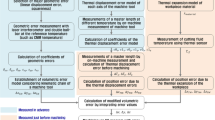Abstract
The drilling process with solid carbide tools with minimum quantity lubrication is under development in the automotive industry due to its high productivity and its environmental benefit. Because of the poor cooling performance when using MQL, a high amount of heat remains in the workpiece, which induces macroscopic thermal distortions and inaccurate parts. This paper presents a methodology to model the thermal distortion of a complex part having a large number of holes. The heat flux entering into the workpiece during each drilling operation is calibrated based on embedded thermocouples and on geometrical observations of the drill surface. Finally, it is shown how the model enables the optimization of a drilling sequence so as to minimize the thermal distortion and the accuracy of the machined part.







Similar content being viewed by others
References
Claudin C, Mondelin A, Rech J, Fromentin G (2010) Influence of a straight oil on friction at the tool-workmaterial interface in machining. Int J Mach Tools Manuf 50:188–681
Courbon C, Sajn V, Kramar D, Rech J, Kosel F, Kopac J (2011) Investigation of machining performance in high pressure jet assisted turning of inconel 718: a numerical model. Int J Mater Process Technol 211(11):1834–1851
Mayr J, Gebhardt M, Massow BB, Weiskert S, Wegener K (2014) Cutting fluid influence on thermal behavior of 5-axis machine tools. Procedia CIRP 14:395–400
Boyer HF, Waremme J, Bourdiol JL, Delaunay D (2011) A study about energy consumption and cutting fluid used to clutch case machining. Mécanique Ind 12:389–393
Braga DU, Diniz AE, Mirand GWA, Coppini NL (2002) Using a minimum quantity of lubricant (MQL) and diamond coated tool in the drilling of aluminum silicon alloy. J Mater Process Technol 122:127–138
Itoigawa F, Childs THC, Nakamura T, Belluco W (2006) Effects and mechanisms in minimal quantity lubrication machining of an aluminum alloy. Wear 260:334–339
Rahman M, Ahaman A, Senthil Kumar A, Salam MU (2002) Experimental evaluation on the effect of minimal quantities of lubricant in milling. Int J Mach Tools Manuf 42:539–547
Sreetjith PS (2008) Machining of 6061 aluminium alloy with MQL, dry and flooded lubricant conditions. Mater Lett 62:276–278
Biermann D, Iovkov I, Blum H, Rademacher A, Taebu K, Suttmeier FT, Klein N (2012) Thermal aspects in deep hole drilling of aluminum cast alloy using twist drills and MAL. Procedia CIRP 3:245–250
Ganesh KC, Vasudevan M, Balasubramanian KR, Chandrasekhar N, Mahadevan S, Vasantharaja P, Jayakumar T (2014) Modeling, prediction and validation of thermal cycles, residual stresses and distortion in type 316 LN stainless steel weld joint made by TIG welding process. Procedia Eng 86:767–774
Lingamanaik SN, Chen BK (2011) Thermo-mechanical modeling of residual stresses induced by martensitic phase transformation and cooling during quenching of railway wheels. J Mater Process Technol 211(9):1547–1552
Jayanti S, Ren D, Erickson E, Usui S, Marusich T, Marisuch K, Elanvogan H (2013) Predictive modeling for tool deflection and part distortion of large machined components. Procedia CIRP 12:37–42
Sukaylo VA, Kaldos A, Krukovsky G, Lierath F, Emmer T, Pieper HJ, Kundrak J, Bana V (2004) Development and verification of a computer model for thermal distortions in hard turning. J Mater Process Technol 155–15:1821–1827
Klocke F, Lung D, Puls H (2013) FEM modeling of the thermal workpiece deformation in dry turning. Procedia CIRP 8:240–245
Schindler S, Zimmermann M, Aurich JC, Steinmann P (2014) Thermo-elastic deformations of the workpiece when dry turning aluminum alloys—a finite element model to predict thermal effects in the workpiece. CIRP J Manufact Sci Technol 7:233–245
Bono M, Ni J (2006) The location of the maximum temperature on the cutting edges of a drill. Int J Mach Tools Manuf 46:901–907
Fleischer J, Pabst R, Kelemen S (2007) Heat flow simulation of dry machining of power train castings. Annals CIRP 56:117–122
Battaglia JL, Kusiak A (2005) Estimation of heat fluxes during high-speed drilling. Int J Adv Manuf Technol 26:750–758
Brandao LC, Coelho RT, Lauro CH (2011) Contribution to dynamic characteristics of the cutting temperature in the drilling process considering one dimension heat flow. Appl Therm Eng 31(17–18):3806–3813
De Sousa OFB, Borges VL, Pereira IC, De Silva MB, Guimaraes G (2012) Estimation of heat flux and temperature field during drilling process using dynamic observes based on green’s function. Appl Therm Eng 48:144–154
Faverjon P (2013) Etude de l’influence tribologique et thermique de la MQL en usinage d’alliage d’aluminium sur la qualité géométrique des pieces prismatiques produites sur centre d’usinage à grande vitesse. Dissertation, University of Lyon -ENISE, Saint-Étienne (France)
Author information
Authors and Affiliations
Corresponding author
Rights and permissions
About this article
Cite this article
Faverjon, P., Rech, J., Valiorgue, F. et al. Optimization of a drilling sequence under MQL to minimize the thermal distortion of a complex aluminum part. Prod. Eng. Res. Devel. 9, 505–515 (2015). https://doi.org/10.1007/s11740-015-0614-y
Received:
Accepted:
Published:
Issue Date:
DOI: https://doi.org/10.1007/s11740-015-0614-y




